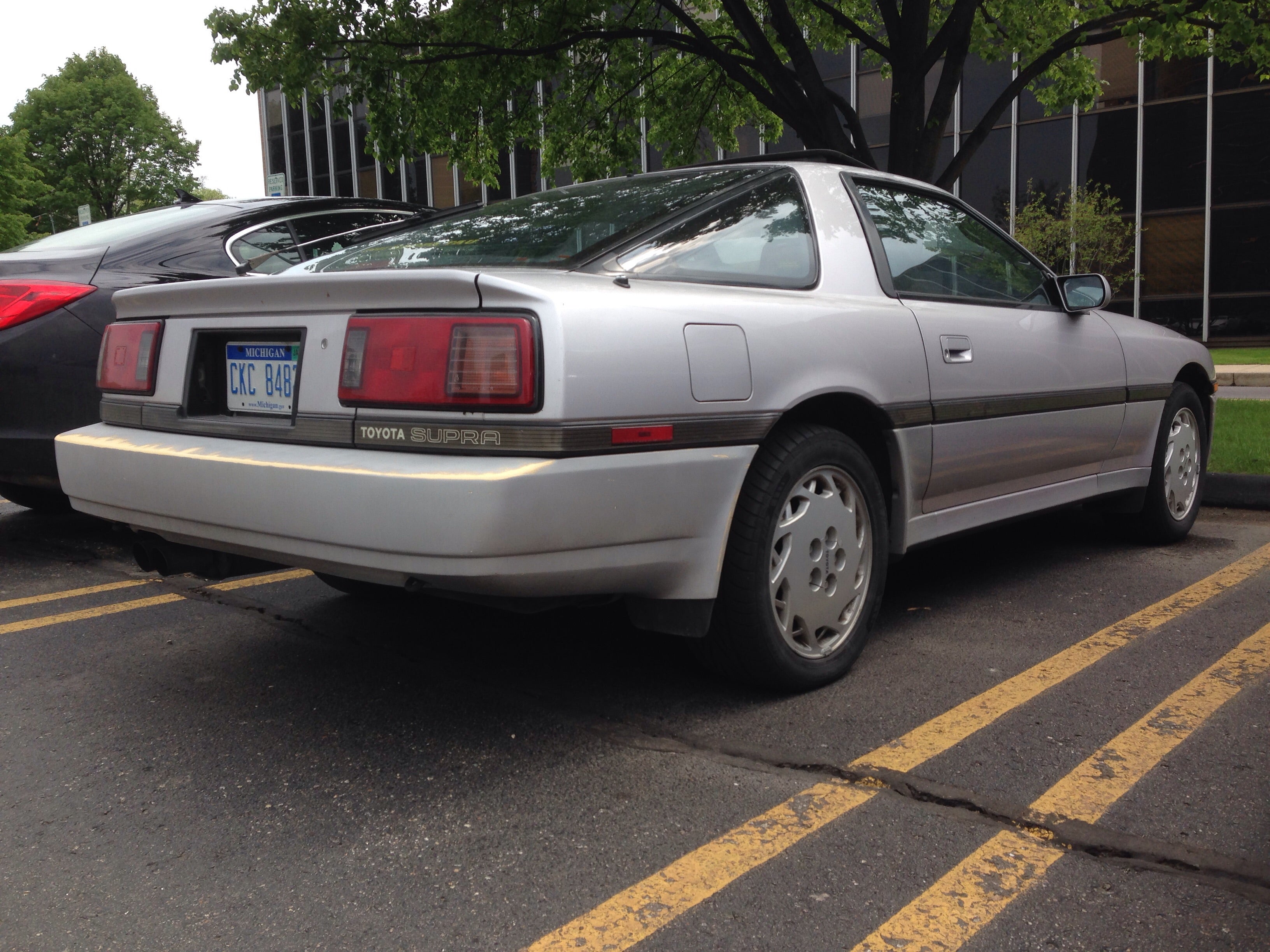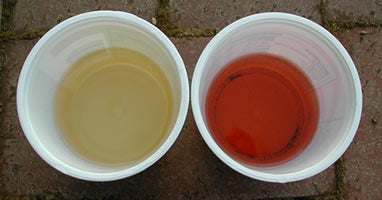 "K-Roll-PorscheTamer" (k-roll390)
"K-Roll-PorscheTamer" (k-roll390)
05/15/2015 at 19:23 ē Filed to: None
 2
2
 32
32
 "K-Roll-PorscheTamer" (k-roll390)
"K-Roll-PorscheTamer" (k-roll390)
05/15/2015 at 19:23 ē Filed to: None |  2 2
|  32 32 |

Have this Supra I found on campus today before the question.
What color is gas when new, and as it ages, what color does it turn to?
 deprecated account
> K-Roll-PorscheTamer
deprecated account
> K-Roll-PorscheTamer
05/15/2015 at 19:26 |
|
Gas is a clear-ish brown-yellow when new, I think.
 K-Roll-PorscheTamer
> deprecated account
K-Roll-PorscheTamer
> deprecated account
05/15/2015 at 19:28 |
|
And it just gets more brown as it ages/degrades?
 deprecated account
> K-Roll-PorscheTamer
deprecated account
> K-Roll-PorscheTamer
05/15/2015 at 19:30 |
|
I guess.
 GeorgeyBoy
> K-Roll-PorscheTamer
GeorgeyBoy
> K-Roll-PorscheTamer
05/15/2015 at 19:31 |
|

 Jedidiah
> K-Roll-PorscheTamer
Jedidiah
> K-Roll-PorscheTamer
05/15/2015 at 19:31 |
|
Ethanol gas is a yellow color when new (100% gas is clear unless theyíve colored it). Some racing fuels use special colorings.
It starts to smell bad when it goes south because it draws water. Unless it has been used with fuel stabilizer, gasoline can go bad as quickly as a month.
 CaptDale - is secretly British
> K-Roll-PorscheTamer
CaptDale - is secretly British
> K-Roll-PorscheTamer
05/15/2015 at 19:32 |
|
Does gasoline really go ďbadĒ if you leave it unused for a period of time? Some people are convinced this is just another urban legend, and that people who worry about ďold gasĒ and spend money on fuel stabilizer are wasting psychic energy as well as cash. Compare stored gasoline with fresh gas. If you notice it is darker or smells sour it is probably bad. But in fact, gasoline can degrade over time. That can lead to a number of problems, ranging from hard starting, to rough running, to no starting at all.
Hereís why
Unlike crude oil, gasoline is a highly refined product brewed to a certain chemical composition with very specific characteristics. One characteristic of gas is volatility, a term used to describe how easily and under what conditions the gas vaporizes so it can be efficiently burned in your carís engine.
The most highly volatile components in gasoline also tend to evaporate over time. As they do, the remaining fuelís volatility and ability to combust properly degrades. The less volatile the fuel, the less effectively it burns in your engine. The result is diminished engine performance. Your engine may still start and run, but it probably wonít run as well.
The good news is, once the old gas has been consumed and the tank is topped off with fresh fuel, the problem should cure itself. Evaporation of volatile compounds can be limited by making sure the gas cap is secured tightly. For the same reason, be sure all portable gas containers are sealed tightly as well.
A more serious problem: Oxidation
Hydrocarbons in the gas react with oxygen to produce new compounds that eventually change the chemical composition of the fuel. This leads to gum and varnish deposits in the fuel system.
These deposits and impurities can clog up gas lines and filters, as well the small orifices in a carburetor and the even smaller orifices in a fuel injector. Removing these deposits can be expensive and your vehicle may not run at all or run very poorly until they are removed.
Water contamination
Condensation can form inside your gas tank and lines from heat cycling. Fuels such as E85, which have a high concentration of ethanol alcohol, may be even more susceptible to water contamination, as ethanol likes to draw moisture out of the surrounding air.
Water contamination can be a problem at gas stations with light traffic due to a slightly different kind of heat cycling. The underground storage tanks experience increases and decreases in temperature. This can cause moisture to form and contaminate the fuel. When you fill up at such a station, youíre pumping in the water along with the gas. Such low-traffic stations may also have other contaminants in their underground storage tanks, such as rust. They are best avoided when possible.
Water, of course, does not work too well as a fuel in an internal combustion engine. It will cause hard starting and rough running until itís purged from the system. It can also contribute to internal rusting of the gas lines and tank. The resultant scale and small particles can create a true nightmare, sometimes requiring the replacement of the gas lines and tank at considerable expense.
You can reduce the chances of water contamination by keeping your carís gas tank as close to full as possible, especially if the vehicle is going to be left idle for an extended period.
How do you identify bad gas?
One way is to eyeball it. Oxidized fuel often turns darker over time and may even smell sour. You can check stored gasoline by pouring some into a clear glass container and comparing it side-by-side with known fresh gasoline. If your old sample looks noticeably darker than the fresh gas, you have strong evidence the gas has gone bad.
How long does it take for gas to go bad?
That depends on a number of factors. For one, itís hard to know how old the gas you just bought actually is. It may be fresh from the refinery, or it may be a month old already by the time you top off your tank. Some gasoline is mixed with better or more oxidation inhibitors than others.
Itís a good rule of thumb to avoid leaving gas in your tank or a storage container for more than a coupe of months, if you can avoid it.
And if you canít?
If you know gas will sit in your tank or a storage container for a couple months, then itís a wise move to buy some fuel system stabilizer and mix it in with the gasoline. Do it before you put the vehicle into long-term storage or before leaving your lawn equipment fuel containers sitting for the winter. The stabilizer helps prevent oxidation, the biggie that can turn gas into garbage that gunks up your system and leads to expensive repair work.
Using fuel system stabilizer for extended storage is preferable to draining the tank and leaving the system dry. This can cause rubber hoses, gaskets and seals to dry-rot and crack, possibly leading to leaks and even a fire. In addition, a dry system can expose the insides of metal fuel lines and your gas tank to air and moisture, which can lead to or accelerate the formation of rust.
Fuel system stabilizer is not a cure-all and it doesnít last forever. It must be mixed with fresh gas before the vehicle is stored, not added to already old gas. It can slow down the oxidation process and keep gas fresh for as long as 12 to 15 months. If youíre going to leave the vehicle parked for longer than that, you may want to drain the tank and refill with fresh fuel before returning the vehicle to service.
(DISCLAIMER: Info copied from CNN and pasted because the articleís design is broken on their end.)
 4muddyfeet - bare knuckle with an EZ30
> K-Roll-PorscheTamer
4muddyfeet - bare knuckle with an EZ30
> K-Roll-PorscheTamer
05/15/2015 at 19:34 |
|
Normally clear with a hint of yellow when fresh, but depending on itís storage container or fuel tank it can go to a translucent brown or reddish colour, and even to a jelly like substance if left long enough. You can normally tell if itís off by the smell though, rather than the colour.
 Scorpio GTX1
> K-Roll-PorscheTamer
Scorpio GTX1
> K-Roll-PorscheTamer
05/15/2015 at 19:37 |
|
I donít know what colour it is, I just know the feeling it gives me when I snort it through a straw.
 K-Roll-PorscheTamer
> GeorgeyBoy
K-Roll-PorscheTamer
> GeorgeyBoy
05/15/2015 at 19:39 |
|
Which is which? Left, new, right, old?
 K-Roll-PorscheTamer
> Jedidiah
K-Roll-PorscheTamer
> Jedidiah
05/15/2015 at 19:39 |
|
Would that prevent ignition or a car to run in general?
 K-Roll-PorscheTamer
> CaptDale - is secretly British
K-Roll-PorscheTamer
> CaptDale - is secretly British
05/15/2015 at 19:41 |
|
So if I have half a tank of almost a year-old gas with a crap ton of octane booster, seafoam, methanol and Sta-bil, what are the odds of that car running or even starting? Please say zero chance.
 K-Roll-PorscheTamer
> 4muddyfeet - bare knuckle with an EZ30
K-Roll-PorscheTamer
> 4muddyfeet - bare knuckle with an EZ30
05/15/2015 at 19:41 |
|
If the gas doesnít smell good and feels slimy in hand, itís probably bad isnít it.
 K-Roll-PorscheTamer
> Scorpio GTX1
K-Roll-PorscheTamer
> Scorpio GTX1
05/15/2015 at 19:42 |
|
Badass

 4muddyfeet - bare knuckle with an EZ30
> K-Roll-PorscheTamer
4muddyfeet - bare knuckle with an EZ30
> K-Roll-PorscheTamer
05/15/2015 at 19:45 |
|
Nah sheíll be right, just turn it and see.
Fill her to the brim with new fuel if you canít be arsed to drain it, but my recommendation would be to drain it. Donít forget your fuel lines...
 K-Roll-PorscheTamer
> 4muddyfeet - bare knuckle with an EZ30
K-Roll-PorscheTamer
> 4muddyfeet - bare knuckle with an EZ30
05/15/2015 at 19:46 |
|
Iím draining it tonight.
 4muddyfeet - bare knuckle with an EZ30
> K-Roll-PorscheTamer
4muddyfeet - bare knuckle with an EZ30
> K-Roll-PorscheTamer
05/15/2015 at 19:47 |
|

 K-Roll-PorscheTamer
> 4muddyfeet - bare knuckle with an EZ30
K-Roll-PorscheTamer
> 4muddyfeet - bare knuckle with an EZ30
05/15/2015 at 19:48 |
|
Perhaps its become so gummy, itís not good enough to run through the lines?
 4muddyfeet - bare knuckle with an EZ30
> K-Roll-PorscheTamer
4muddyfeet - bare knuckle with an EZ30
> K-Roll-PorscheTamer
05/15/2015 at 19:49 |
|
How long has it been sitting? And in what car?
 CaptDale - is secretly British
> K-Roll-PorscheTamer
CaptDale - is secretly British
> K-Roll-PorscheTamer
05/15/2015 at 19:54 |
|
If it runs on snake oil, water, and goo then it should start no problem.
 BaconSandwich is tasty.
> K-Roll-PorscheTamer
BaconSandwich is tasty.
> K-Roll-PorscheTamer
05/15/2015 at 19:57 |
|
New on the left, old on the right.
 K-Roll-PorscheTamer
> 4muddyfeet - bare knuckle with an EZ30
K-Roll-PorscheTamer
> 4muddyfeet - bare knuckle with an EZ30
05/15/2015 at 19:58 |
|
In our 911. It's been close to a year now since we let it sit. I pulled the filter earlier and it feels more like slime than liquid but still flows. It has Seafoam, octane booster, methanol, and Sta-bil all from last year. And I think it's heavily diluted.
 Arch Duke Maxyenko, Shit Talk Extraordinaire
> GeorgeyBoy
Arch Duke Maxyenko, Shit Talk Extraordinaire
> GeorgeyBoy
05/15/2015 at 19:58 |
|
Red gas hasnít been used for decades. And it just signifies that itís unleaded.
 K-Roll-PorscheTamer
> BaconSandwich is tasty.
K-Roll-PorscheTamer
> BaconSandwich is tasty.
05/15/2015 at 19:59 |
|
The gas I saw looks more like what's on the right.
 4muddyfeet - bare knuckle with an EZ30
> K-Roll-PorscheTamer
4muddyfeet - bare knuckle with an EZ30
> K-Roll-PorscheTamer
05/15/2015 at 20:04 |
|
Well your filter is gonna be the worst part of your fuel system, as that is the nature of its job. Have you tried turning it over? I donít know what the tanks are like on 911ís, but if theyíre ventilated in any way then itís probably bad. Water in your fuel is a no-no, and if the car has experienced temperature changes while itís been stored then there may well have been water ingress. What fuel was last put in it? Any detergents and additives in the fuel can Ďgo badí before the fuel actually does, so that may account for the sliminess, but tbh Iíd play it safe for the sake of a couple of hours work and a new tank of gas.
 BaconSandwich is tasty.
> K-Roll-PorscheTamer
BaconSandwich is tasty.
> K-Roll-PorscheTamer
05/15/2015 at 20:05 |
|
Probably not the end of the world.
 GeorgeyBoy
> Arch Duke Maxyenko, Shit Talk Extraordinaire
GeorgeyBoy
> Arch Duke Maxyenko, Shit Talk Extraordinaire
05/15/2015 at 20:06 |
|
http://www.alpharubicon.com/altenergy/gaslÖ
Gas is from 1995. Leaded stopped in the 70ís didnít it?
 Arch Duke Maxyenko, Shit Talk Extraordinaire
> GeorgeyBoy
Arch Duke Maxyenko, Shit Talk Extraordinaire
> GeorgeyBoy
05/15/2015 at 20:10 |
|
1995 is decades old now, and yes even though leaded gasoline ended well before that red was still used to differentiate unleaded from leaded
 GeorgeyBoy
> Arch Duke Maxyenko, Shit Talk Extraordinaire
GeorgeyBoy
> Arch Duke Maxyenko, Shit Talk Extraordinaire
05/15/2015 at 20:16 |
|
I thought red was and still is used for high sulfer gas or jet fuel? Canít really find anything about it. All stale gas pics seem to be the brownish red color.
 dogisbadob
> K-Roll-PorscheTamer
dogisbadob
> K-Roll-PorscheTamer
05/15/2015 at 20:38 |
|
By the time youíd see gas go bad, wouldnít it already have evaporated or been used?
Gasoline is clear AFAIK
 Arch Duke Maxyenko, Shit Talk Extraordinaire
> GeorgeyBoy
Arch Duke Maxyenko, Shit Talk Extraordinaire
> GeorgeyBoy
05/15/2015 at 20:43 |
|
Red for high sulfur off road gas, but all unleaded used to be red.
 Jedidiah
> K-Roll-PorscheTamer
Jedidiah
> K-Roll-PorscheTamer
05/15/2015 at 22:09 |
|
It would make it idle rough or hard to start.
If ethanol gas sits in fuel lines to long it can ruin them, which can be annoying.
 NJAnon
> K-Roll-PorscheTamer
NJAnon
> K-Roll-PorscheTamer
05/17/2015 at 10:11 |
|
What did you do K-Roll?